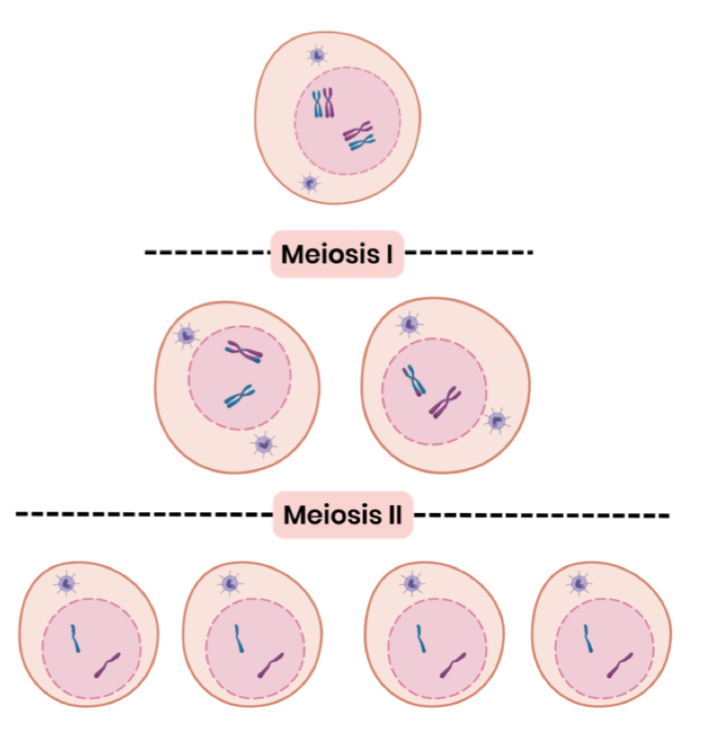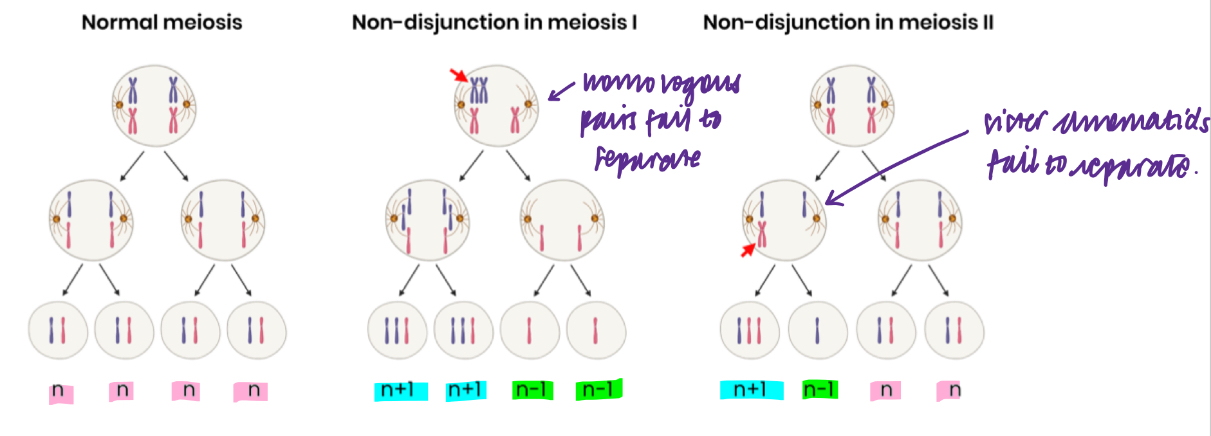4.3 Genetic Diversity can arise as a result of mutation or meiosis
1/19
There's no tags or description
Looks like no tags are added yet.
Name | Mastery | Learn | Test | Matching | Spaced |
|---|
No study sessions yet.
20 Terms
What is a gene mutation?
a change in the base sequence of DNA (or chromosomes)
Can arise spontaneously during DNA replication (interphase)
What is a mutagenic agent?
A factor that increases rate of gene mutation, e.g. ultraviolet (UV) light or alpha particles
Explain how a mutation can lead to the production of a non-functional protein or enzyme
Change sequence of base triplets in DNA (in a gene) so changes sequence of codons on mRNA
So changes sequence of amino acids in the polypeptide
So changes position of hydrogen / ionic / disulphide bonds (between amino acids)
So changes protein tertiary structure (shape) of protein
Enzymes - active site changes shape so substrate can’t bind, enzyme-substrate can’t form
Explain the possible effects of a substitution mutation
DNA base / nucleotide (pair) replaced by a different base / nucleotide (pair)
This changes one triplet so changes one mRNA codon
So one amino acid in polypeptide changes
tertiary structure may change if position of hydrogen / ionic / disulphide bonds change
OR amino acid doesn’t change
due to degenerate nature of genetic code (triplet could code for same amino acid) OR if a mutation is in an intron so removed during splicing
Explain the possible effects of a deletion mutation.
One nucleotide / base (pair) removed from DNA sequence
Changes sequence of DNA triplets from point of mutation (frameshift)
Changes sequence of mRNA codons after point of mutation
Changes sequence of amino acids in primary structure of polypeptide
Changes position of hydrogen / ionic / disulphide bonds in tertiary structure of protein
Changes tertiary structure / shape of protein
Describe features of homologous chromosomes
same length, same genes at same loci, but may have different alleles
Describe the difference between diploid and haploid cells
diploid - has 2 complete sets of chromosomes, represented as 2n
Haploid - has a single set of unpaired chromosomes, represented as n
Describe how a cell divides by meiosis
In interphase, DNA replicates → 2 copies of chromosomes (sister chromatids), joined by a centromere
Meiosis I (first nuclear division) separates homologous chromosomes
chromosome arrange into homologous pairs
Crossing over between homologous chromosomes
Independent segregation of homologous chromosomes
Meiosis II (second nuclear division) separate chromatids
What is the outcome of meiosis?
4 genetically varied daughter cells
Daughter cells are normally haploid (if diploid parent cell)
Draw a diagram to show the chromosome content of cells during meiosis
*You should be able to complete diagrams showing chromosome contents of cells after the first and second meiotic division, when given the chromosome content of the parent cell

Explain why the number of chromosomes is halved during meiosis
Homologous chromosomes are separated during meiosis I (first nuclear division)
Explain how crossing over creates genetic variation
homologous pairs of chromosomes associate / form a bivalent
Chiasmata form (point of contact between (non-sister) chromatids)
Alleles / (equal) lengths of (non-sister) chromatids exchanged between chromosomes
Creating new combinations of (maternal + paternal) alleles on chromosomes
Explain how independent segregation creates genetic variation
homologous pairs randomly align at equator → so random which chromosome from each pair goes into each daughter cell
Creating different combinations of maternal + paternal chromosomes / alleles in daughter cells
Other than mutation and meiosis, explain how genetic variation within a species is increased
random fertilisation / fusion of gametes
Creating new allele combinations / new maternal and paternal chromosome combinations
Explain the different outcomes of mitosis and meiosis
Mitosis produces 2 daughter cells, whereas meiosis produces 4 daughter cells
as 1 division in mitosis, whereas 2 divisions in meiosis
Mitosis maintains the chromosome number (e.g. diploid→ diploid or haploid→ haploid) whereas meiosis halves the chromosome number (e.g. diploid→ haploid)
as homologous chromosomes separate in meiosis but not mitosis
Mitosis produces genetically identical daughter cells, whereas meiosis produces genetically varied daughter cells
as crossing over and independent segregation happen in meiosis but not mitosis
Explain the importance of meiosis
2 divisions create haploid gametes (halves number of chromosomes)
So diploid number is restored at fertilisation → chromosome number maintained between generations
Independent segregation and crossing over creates genetic variation
How can you recognise where meiosis and mitosis occur in a life cycle?
mitosis occurs between stages where chromosome number is maintained
- e.g. diploid (2n) → diploid (2n) OR haploid (n) → haploid (n)
Meiosis occurs between stages where chromosome number halves
- e.g. diploid (2n) → haploid (n)
Describe how mutations in the number of chromosomes arise
spontaneously by chromosome non-disjunction during meiosis
Homologous chromosomes (meiosis I) or sister chromatids (meiosis II) fail to separate during meiosis
So some gametes have an extra copy (n+1) of a particular chromosome and other have none (n-1)

Suggest how the number of possible combinations of chromosomes in daughter cells following meiosis can be calculated
2^n where n = number of pairs of homologous chromosomes (half the diploid number)
Suggest how the number of possible combinations of chromosomes following random fertilisation of two gametes can be calculated
(2n)² where n = number of pairs of homologous chromosomes (half the diploid number)